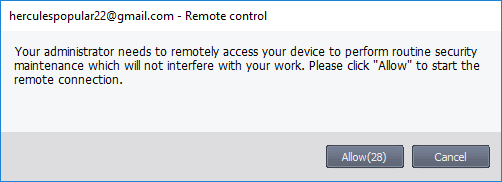Remote Tools Settings
-
Remote tool settings let you configure how you connect to managed endpoints
-
There are two ways you can remotely connect:
-
Remote Tools - View and manage remote computers via the Xcitium console. Click 'Assets' > 'Devices' > 'Device List' > select a running Windows device > click 'Remote Tools' > 'File Explorer' / 'Process Explorer' / 'Service Explorer'.
-
Remote Control - Take-over the remote device like a traditional RDP connection. Click 'Assets' > 'Devices' > 'Device List' > select a running Windows device > Click 'Remote Control'.
-
The endpoint must have communication client v. 6.25 or higher installed to configure remote tool settings.
Remote tool settings let you configure how you connect to managed endpoints
There are two ways you can remotely connect:
-
Remote Tools - View and manage remote computers via the Xcitium console. Click 'Assets' > 'Devices' > 'Device List' > select a running Windows device > click 'Remote Tools' > 'File Explorer' / 'Process Explorer' / 'Service Explorer'.
-
Remote Control - Take-over the remote device like a traditional RDP connection. Click 'Assets' > 'Devices' > 'Device List' > select a running Windows device > Click 'Remote Control'.
The endpoint must have communication client v. 6.25 or higher installed to configure remote tool settings.
Configure Remote Tools Settings
-
Click 'Assets' > 'Configuration Templates' > 'Profiles'
-
Open the Windows profile you want to work on
-
Click the 'Remote Tools' tab then 'Edit', if it has already been added to the profile
OR
-
Click 'Add Profile Section' > 'Remote Tools' if it hasn't yet been added
-
File Explorer - Enable the ability to view files on the remote system.
-
Perform actions - Enable the ability to create / rename / move / delete files on the remote system.
-
File / Folder Transfer - Enable the ability to copy files to and from the remote system.
-
Process Explorer - Enable the ability to view and manage running processes and services on the remote system.
-
Commands Interface - If enabled, you can run command lines and power shell commands on remote devices' command prompt.
Alternatively, use the 'Apply to all' switch at the top to enable or disable all at-once.
-
Establish Remote Tools sessions without asking user permission - The remote connection will be established without showing a request to the user.
-
Ask user, wait and allow access - A message is shown to the user which requests them to accept the connection. The connection is established if the user does not respond within the timeout period.
Enter the timeout period (in seconds) in the text box
An example request message is shown below:
-
Ask user, wait and deny access - A message is shown to the user which requests them to accept the connection. The connection attempt is abandoned if the user does not respond within the timeout period.
Enter the timeout period (in seconds) in the text box
Message to Device User
-
Enter the text of the request message. For example, 'Your administrator needs to remotely access your device to perform routine maintenance. Please click "Allow" to start the remote connection.'
Note - You can only enter a message if you choose one of the 'Ask...' settings.
Client Notification Options
This area lets you configure the notification box which is shown on the endpoint when a remote session is active. An example is shown below:

The end-user can view the actions taken on the endpoint by clicking the down arrow at the right of the notification box.
-
Show notification to device user about who connected to his/her workstation - Enable or disable the notification box
Allow endpoint user to terminate the connection - Choose whether or not the 'End Session' button is shown in the notification box. If enabled, the end-user will be able to close the connection.
Keep notification windows open upon remote session termination - Choose whether or the notification box should be shown on the endpoint after the session is completed.





